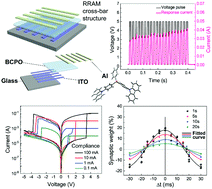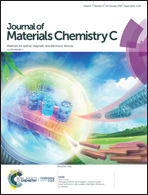A bio-inspired electronic synapse using solution processable organic small molecule†
Abstract
Mimicking biological synapses with resistive random switching memory (RRAM) can lay a concrete foundation for the future of artificial intelligence. RRAMs based on low-cost and solution-processed organic materials provide a competitive approach. Here, we report an artificial synaptic device with a solution-processed small molecule (bis-4-(N-carbazolyl)phenyl)phenylphosphine oxide (BCPO) based RRAM. The BCPO-based RRAM exhibits reproducible resistive switching behavior, a long retention time as well as good thermal tolerance with a sufficient on/off current ratio. In situ Kelvin probe force microscopy (KPFM), conductive atomic force microscopy (C-AFM) and density function theory (DFT) calculations demonstrate that both the redox state and the trap-filled space charge limited current (SCLC) determine the resistive switching of a BCPO-based RRAM. Furthermore, the fabricated device was employed to emulate a biological synapse in which several synaptic functions, including spike-rate-dependent plasticity (SRDP), a transition from short-term plasticity (STP) to long-term plasticity (LTP) and spike-time-dependent plasticity (STDP), were realized. To the best of our knowledge, this is the first successful demonstration of solution-processed small molecules in artificial synaptic devices. The BCPO layer is solution-processed at low temperature which is compatible with a flexible substrate and printable electronics. We believe this electronic synapse will have a wide range of applications in future neuromorphic computing.

- This article is part of the themed collection: 2019 Journal of Materials Chemistry C Most Popular Articles


 Please wait while we load your content...
Please wait while we load your content...